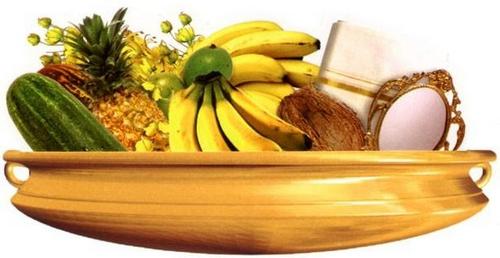
Vishu kani is the most important thing of Vishu. Kani means the first sight. Therefore, people consider the first thing you see on a day will decide your day. The same way the first thing you see on New Year will decide the luck and prosperity for your coming new year. So seeing auspicious things on vishu morning as the first sight of the day is known as vishu kani.
Vishu Kani Preparation
A reasonably sized Uruli is used to arrange the Kani. Uruli is an open-mouthed shallow circular vessel made out of bell metal. It is available in all sizes from a diameter of a few inches to even 10–12 feet! . The uruli traditionally is made of panchaloham, an aggregate of five metals. Panchaloham being symbolic of the universe, which comprises the five great elements—earth, water, fire, air and space.
Placed over that is a freshly laundered white kasavu pudava (a typical Kerala style Sarang with golden embroidery), followed by a carefully selected Kanivellari (golden coloured, shapely cucumber), Vettila (betel leaves), Pazhukkapakku (reddish yellow coloured ripe areca nut), golden coloured mango fruit, ripe yellow jack fruit(halved) and a Aranmula valkannadi (Aranmula Kannadi’s are an auspecious item for Ashtamangalyam, It is considered as the symbol of good luck, wealth and prosperity).
A nice, well-starched cloth is then pleated fan-like and inserted into a highly polished brass kindi (a spouted puja vessel used for pouring sacred water). The val-kannadi, a special type of mirror with an extremely long and thin handle, often decorated with gold, is also inserted into the kindi. The kindi is then placed in the uruli on top of the rice.
Then in a small flat-bottomed vessel is kept a little rice, a silver coin and some flowers. After the Kanikanal, thinking of a wish, if one takes the coin and check if its top side is head or tail. Depends on this one may know if his/her wish would be realized or not.
Now keep the Kani Uruli in front of the statuette or picture of Sree Krishna Bhagavan (in Northern Kerala, the valkannadi signifies or is the embodiment of Sree Bhagavathi, the Jaganmata Jagadeeswari). Then decorate the Kani Uruli, Picture and the surroundings with Konnappoovu (Indian Laburnum). lace a lit Nilavilakku (bronze oil lamp) nearby in such a way as it imparts a golden yellow hue to the Kani-ambience.
Two deepams, which are fashioned from the two halves of a split coconut, are also kept in the uruli. The wicks are made from pieces of starched cloth that are folded into bulbs at the base. These bulbs are placed into the coconut oil that fills the deepams, anchoring the wicks in place. The starch helps the rest of the wick to extend straight upwards so that they will properly burn. The lighting of the deepam welcomes God into our lives and is also symbolic of spiritual knowledge—the remover of the darkness of ignorance.
Now the subdued yellow splendour of Nilavilakku and its brilliant reflections on the bronze Uruli, golden coloured kanivellari, gold ornaments and bronze mirror boost the overwhelmingly yellow abundance of the Kanikonna flower clusters and in turn augment the beauty of the yellow clad divinity that is Lord Sree Krishna Paramatma. When one opens the eyes for the first time in the Brahma Muhurtha, to look at Bhagavan’s this glorious image, where is the chance that any thing can go wrong in the new year, why the whole life?
Gold—both in colour and in coin—is central to the Vishukkani. Kanikkonna, a golden-yellow flower is used liberally throughout the puja room. This flower only blooms when the sun is in its most exalted position astrologically—the month surrounding Vishu. In the puja room, the flower verily represents the sun itself, the eyes of Lord Vishnu. Gold coins are symbols of monetary affluence, as well as cultural and spiritual wealth, which the elders of the family must share freely with the younger generation. Vishukkaineettam, the distribution of wealth, is another aspect of the festival. It should be given freely and accepted with reverence. On Vishu, the highly affluent families will not only give money to their children but also their neighbours, perhaps the entire village.
The grandmother or mother who arranges the Vishukkani will sleep in the puja room after she is finished and then, waking during the auspicious hour of the Brahma muhurata (4:00 to 6:00 a.m.), she will light the oil-lamp wicks and take in the auspicious sight. She will then walk to the rooms where the rest of the family is sleeping and wake them. Covering their eyes, she will then lead them to the puja room, where she will allow them to take in the auspicious sight.
Upon opening one’s eyes, one is overwhelmed with the glorious darshan of the Lord. The mirror—which is symbolic of Bhagavati (Devi), not only increases the lustre of the Vishukkani via the reflection it offers, but also shows our own face. One may also be reminded at this time, that Bhagavan SriKrishna is the supreme lord of all that be, and our eternal duty(Sanatana Dharma) as eternal spirit souls (jivatma) is to render devotional service unto the Him, utilizing all these material requirements provided by Him for our well-being in the coming year also. The mirror also points to the importance of making our mind pure enough to render devotional service (Nava vidha bhakti) with true and unadulterated love to SriKrishna
The Vishukkani is not reserved only for those who come to the puja room, but is taken around—for the viewing of the elderly and sick who are perhaps too frail to come to the shrine. It is also brought outside and shown to the family cows. As it is brought to the cowshed, it in fact is on display for the birds, the trees, for all of nature to see.
Vishukkani points to a year of abundance—both spiritually and materially. Food, light, money, knowledge—all should fill our life. Taking in the Vishukkani we should pray that the vision remains with us throughout the year. It is not enough that the joy we take from viewing the Vishukkani comes only to our eyes. It must reflect in our thoughts and in our actions. The auspicious start of the year—which has come to us due to the grace of beginning it with a divine vision—is not for us alone. It is up to us to spread this love, happiness and hope to the rest of society.
 TechnoparkToday.com – Techies News, Jobs, Events & Lifestyle! Technopark News Jobs & Lifestyle!
TechnoparkToday.com – Techies News, Jobs, Events & Lifestyle! Technopark News Jobs & Lifestyle!




Informative article…now wheres the vishu kaineettam ?
very good article. it explains really well. thanks for helping me to prepare a very traditional vishukani. thanks a lot.